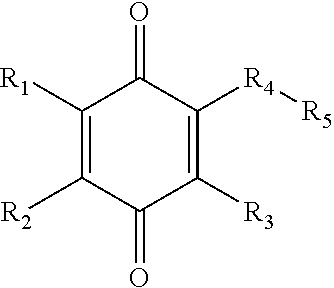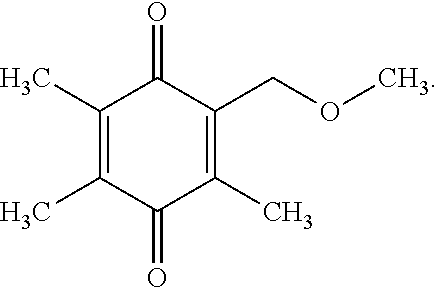Fluoroalkyl, fluoroalkoxy, phenoxy, heteroaryloxy, alkoxy, and amine 1,4-benzoquinone derivatives for treatment of oxidative stress disorders
derivatives, which is applied in the field of fluoroalkoxy, fluoroalkoxy, phenoxy, heteroaryloxy, alkoxy, and amine 1, 4benzoquinone derivatives for treatment of oxidative stress disorders, can solve the problems of oxidative damage to the cellular structure and machinery, cell damage and cell death, and the rate of damage to the cell membrane exceeds the capacity of systems which control or repair, so as oxidative stress disorder, oxidative stress disorder oxidative stress disorder oxidative stress disorder oxidative stress disorder, a technology of oxidative stress disorder, a technology of oxidative stress disorder, a technology of a oxidative stress disorder and a technology of a oxidative stress disorder and a technology of a oxidative stress disorder and a technology of a a technology of a phenotype, which is applied in the field of phenotype, phenotype, phenotype, phenotyp
- Summary
- Abstract
- Description
- Claims
- Application Information
AI Technical Summary
Benefits of technology
Problems solved by technology
Method used
Image
Examples
example 1.2 , 3 , 5
Example 1. 2,3,5-trimethyl-6-(8-(2,2,2-trifluoroethoxy)octyl)cyclohexa-2,5-diene-1,4-dione
[0202]
Step 1. 9-hydroxynonanoic acid (2)
[0203]
[0204]To a solution of 9-methoxy-9-oxononanoic acid (1) (2.0 g, 9.89 mmol, 1.0 eq) in dioxane / water (v / v, 25 mL / 25 mL) was added NaBH4 (2.6 g, 70.27 mmol, 7.0 eq) in portions. The reaction mixture was stirred at 25° C. for one night. Then the mixture was quenched by 1N aqueous solution of hydrochloric acid at 0° C. and extracted with dichloromethane (3×30 mL). The organic layers were dried over anhydrous Na2SO4 and concentrated to give 9-hydroxynonanoic acid (2) (2.0 g, 99%) which was used directly to next step without purification.
Step 2. Methyl 9-hydroxynonanoate (3)
[0205]
[0206]To a solution of 9-hydroxynonanoic acid (2) (1.0 g, 5.74 mmol, 1.0 eq) in methanol (30 mL) was added sulfuric acid (1 mL). The reaction mixture was heated to reflux for 5 h. Then the mixture was concentrated under reduced pressure and the residue was diluted with water (15 ...
example 2.2 , 3 , 5
Example 2. 2,3,5-trimethyl-6-(9,9,9-trifluorononyl)cyclohexa-2,5-diene-1,4-dione
[0215]
Step 1. Non-8-enoic acid (9)
[0216]
[0217]Magnesium (2.76 g, 0.114 mol, 1.1 eq) and a grain of iodine in three-neck flask was degassed with nitrogen. Then 25 percent volume of 8-bromooct-1-ene (8) (20 g, 0.105 mol, 1.0 eq) in THF (250 mL) was added into the mixture and the stirred mixture was heated to 70° C. until yellow brown disappeared. Then the remaining solution was added into the mixture dropwise and stirred at that temperature for additional 4 h. The solution was cooled to rt and CO2(s) (46.2 g, 1.05 mol, 10.0 eq) in THF was added. After the addition, the mixture was warmed to rt and quenched by saturated solution of NH4Cl. Then the mixture was extracted with ethyl acetate, separated and the organic phase was dried over Na2SO4, concentrated under reduced pressure. The residue was purified by column chromatography (PE / EA=100:1 to 50:1) to give non-8-enoic acid (9) (8.9 g, 54%).
Step 2. Methyl n...
example 3.2
Example 3. 2-(8-methoxyoctyl)-3,5,6-trimethylcyclohexa-2,5-diene-1,4-dione
[0228]
Step 1. Methyl 9-methoxynonanoate (14)
[0229]
[0230]To a solution of methyl 9-hydroxynonanoate (3) (1.15 g, 6.11 mmol, 1.0 eq) in DMF (Dimethylformamide) (20 mL) was added NaH (60%, 337 mg, 9.17 mmol, 1.5 eq) at 0° C. After stirring 2 h at rt, iodomethane (1.3 g, 9.16 mmol, 1.5 eq) was added into the mixture and stirred at rt for 2 h. The mixture was quenched saturated aqueous solution of NH4Cl (20 mL) and extracted with ethyl acetate (3×20 mL). The organic layers were dried over Na2SO4 and concentrated. The residue was purified by column chromatography (PE / EA=20:1) to give methyl 9-methoxynonanoate (14) (1.1 g, 89%).
Step 2. 9-methoxynonanoic acid (15)
[0231]
[0232]To a solution of methyl 9-methoxynonanoate (14) (1.1 g, 5.44 mmol, 1.0 eq) in methanol / THF (v / v, 20 mL / 20 mL) was added 10% aqueous solution of sodium hydroxide (11 mL, 27.2 mmol, 5.0 eq) at rt. The reaction mixture was stirred at rt overnight. Th...
PUM
| Property | Measurement | Unit |
|---|---|---|
| weight percent | aaaaa | aaaaa |
| weight percent | aaaaa | aaaaa |
| weight percent | aaaaa | aaaaa |
Abstract
Description
Claims
Application Information
 Login to View More
Login to View More - R&D
- Intellectual Property
- Life Sciences
- Materials
- Tech Scout
- Unparalleled Data Quality
- Higher Quality Content
- 60% Fewer Hallucinations
Browse by: Latest US Patents, China's latest patents, Technical Efficacy Thesaurus, Application Domain, Technology Topic, Popular Technical Reports.
© 2025 PatSnap. All rights reserved.Legal|Privacy policy|Modern Slavery Act Transparency Statement|Sitemap|About US| Contact US: help@patsnap.com



